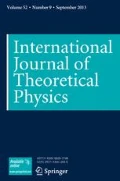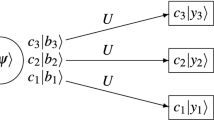Abstract
The famous “spooky action at a distance” in the EPR-scenario is shown to be a local interaction, once entanglement is interpreted as a kind of “nearest neighbor” relation among quantum systems. Furthermore, the wave function itself is interpreted as encoding the “nearest neighbor” relations between a quantum system and spatial points. This interpretation becomes natural, if we view space and distance in terms of relations among spatial points. Therefore, “position” becomes a purely relational concept. This relational picture leads to a new perspective onto the quantum mechanical formalism, where many of the “weird” aspects, like the particle-wave duality, the non-locality of entanglement, or the “mystery” of the double-slit experiment, disappear. Furthermore, this picture circumvents the restrictions set by Bell’s inequalities, i.e., a possible (realistic) hidden variable theory based on these concepts can be local and at the same time reproduce the results of quantum mechanics.
Similar content being viewed by others
References
Barbour, J. B. and Bertotti, B. (1977). Nuovo Cimento B 38, 1.
Barbour, J. B. and Bertotti, B. (1982). Proceedings of the Royal Society of London A 382, 295.
Born, M. (ed.) (1971). The Born-Einstein Letters Macmillan, London.
Bruβ, D. (2001). Proceedings of the ICQI Rochester Conference, lanl e-print quant-ph/0110078.
Clarke, S. (1716). A collection of papers which passed between the late learned Mr. Leibniz and Dr. Clarke in the years 1715–1716 relating to the principles of natural philosophy and religion.
Coecke, B. (2000). The Logic of Entanglement. An Invitation. Research Report PRG-RR-01-12 Oxford University Computing Laboratory (available at web.comlab.ox.ac.uk/oucl/publications/tr/rr-03-12.html
Descartes, R. (1644). Principia Philosophiae, Apud Ludovicum Elzevirium, Amsterdam.
deWitt, B. S. (1970). Quantum Mechanics and Reality Physics Today; Sept., 30–35.
Everett, H. (1957). “Relative state” formulation of quantum mechanics. Reviews of Modern Physics 29, 454.
Feynman, R. P., Leighton, R. B., and Sands, M. (1965). The Feynman Lectures on Physics Addison Wesley, Reading, MA, Vol. III, Chapter 1.
Haag, R. (1990). Communication in Mathematical Physics 132, 245.
Haag, R. (2004). Mind and Matter 2/2, 53.
Hasegawa, Y., Loidl, R., Badurek, G., Baron, M., and Rauch, H. (2003). Violation of a Bell-like inequality in single-neutron interferometry. Nature 425, 45.
Hill, S. and Wootters, W. K. (1997). Physics Review Letters 78, 5022.
Horodecki, M., Horodecki, P., and Horodecki, R. (1996). Physics Letters A 223,1.
Leibniz, G. W. (1954). Principes de la Philosophie ou Monadologie Presse Universitaires de France, Paris.
Mach, E. (1883). Die Mechanik in ihrer Entwicklung historisch-kritisch dargestellt (English The Science of Mechanics), F. A. Brockhaus, Leipzig.
Penrose, R. (1972). In Magig without Magic, J. R. Klauder, ed. Freeman, San Francisco.
Plesch, M. and Bužek, V. (2003). Physics Review A 67, 012322.
Requardt, M. (2000). Classical and Quantum Gravity 17, 2029.
Rovelli, C. and Smolin, L. (1990). Loop space representation of quantum general relativity. Nuclear Physics B331 (1990) 80.
Rovelli, C. (2004). Quantum Gravity, Cambridge Monographs on Mathematical Physics, Cambridge University Press, Cambridge, 2004.
Sorkin, R. D. (1991). International Journal of Theoretical Physics 30, 323.
Weinberg, S. (2000). The Quantum Theory of Fields Cambridge University Press.
Wootters, W. K. (1998). Physics Review Letters 80, 2245.
Author information
Authors and Affiliations
Additional information
PACS: 03.65.Ud, 04.60.Nc
Rights and permissions
About this article
Cite this article
Filk, T. Relational Interpretation of the Wave Function and a Possible Way Around Bell’s Theorem. Int J Theor Phys 45, 1166–1180 (2006). https://doi.org/10.1007/s10773-006-9125-0
Received:
Accepted:
Published:
Issue Date:
DOI: https://doi.org/10.1007/s10773-006-9125-0




